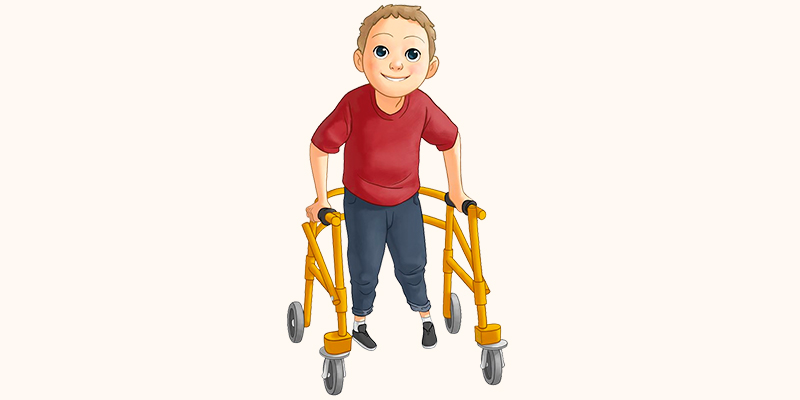If there was anything that I could use my magic wand on, to make it work better, it would be to treat Dystonia in Cerebral Palsy. In my experience, this is one of the most challenging conditions and the management of dystonia and the associated pain, in children with Cerebral Palsy, is like discovering a new piece of the puzzle each time during treatment.
Children with dystonia have described their experience and have provided an exemplary illustration of this sometimes-frustrating condition. They say that “the most difficulty faced is when their legs and feet are flying off the footplates of their wheelchair, with the sense of no control over their own body sliding from the safety of the chair; they often feel stuck in a posture and live through a sense of being trapped inside one’s own body.”
Definition of Dystonia
Dystonia is a movement disorder in which involuntary sustained or intermittent muscle contractions cause twisting and repetitive movements, abnormal postures, or both.
Hallmark features of Dystonia
- The movement patterns demonstrated by the child vary with change in position, for instance a child may have a scissoring posture in lower limbs in standing and a splayed posture with legs turned out in sitting. This is characteristic of dystonia and distinguishes it from hypertonia.
- Dystonia is an unintentional movement and cannot be cognitively controlled
- It is fluctuating in nature and presents with increase or decrease in tone influenced by trigger factors like beginning of a movement, effort, emotions elicited during the task, external touch or general health conditions.
- The muscles typically become stiff with purposeful movements of a distal body part
- The postures are twisting in nature and can affect single or multiple body segments or the entire body.
- It presents with an All or nothing Phenomena where either the child is contracting every muscle in the body segment or switching off completely with a collapse or end in movement.
Observations from a clinician’s perspective
- The child will have difficulty initiating movements in the trunk e.g. Pulling up to sit from a lying position
- Difficulty with sustaining and terminating the muscle contraction in the limbs e.g. Opening a fist to grasp a toy or letting go to release a toy.
- When the termination occurs, it is more throughout the body rather than one specific muscle group, that results in a collapse in the child e.g. A sudden drop of the arm whilst raising it to reach
- Recruitment of postural motor units is challenging e.g. holding head and neck muscles for longer than a few seconds
- Recruitment of movement is compensating for the loss of postural muscles e.g. overuse of the muscles that are meant for fast, repetitive movements are being used for balance and stability.
- The phasic motor units are recruited atypically to sustain activation rather than allowing alternating / reciprocating movements e.g. holding the arm in shoulder elevation with arms turned inwards and fisted in sitting for stability.
- Eccentric control is most affected e.g. Lowering down to sitting from standing with control
- Movements are least observed in midranges and are more end range patterns of all bending or all straightening
- The fluidity of movement is ungraded
Diagnosis and its Implications
Here is the interesting aspect of dystonia wherein it is commonly misdiagnosed as increased spasticity or hypertonicity. The HAT (Hypertonia Assessment tool) is used to distinguish dystonia from hypertonia and spasticity.
Once determined by the health care team if dystonia is present, categorizing it into generalized or focal dystonia is vital. It also affects the laryngeal muscles, eyes and the oro-motor area as focal segments in some children.
It is often confusing and misleading due to its co-existence with other movement disorders like athetosis, ataxia or spasticity. Two children with the same severity of dystonia could present with opposite pictures in their movement: one with slowness in movement and one with excessive movement.
Determining the cause of dystonia from brain imaging studies, having reports to support the diagnosis and it being in line with Cerebral Palsy is extremely vital for its medical line of treatment.
Sensory influences like tactile stimulus to a body part can evoke dystonic posturing in the limb or body segment.
On the other hand, a fascinating phenomenon occurs in children with dystonia called a sensory trick: A clue that could be utilized to make a child function better: Hooking the hand on the head for stability or holding it snugly to the chest with elbow flexion could promote better walking and straightening out of legs against gravity.
Identifying secondary health impairments which often worsen the dystonia include:
- Gastro-intestinal issues like acid reflux
- Discomfort from constipation
- Sleep disturbances due to pain elicited from dystonia
- Nutritional deficits and risk of developing osteoporosis
- Soft tissue restrictions
- Bony changes and risk of hip dislocation
Treatment options for Dystonia
- Therapeutic strategies and rehabilitation towards functional independence, improving comfort and quality of life, positioning and seating are attended with an interdisciplinary approach involving the Physical Therapist, Occupational Therapist and Speech and Language Therapist.
- Physical Therapy is centered around strengthening the core muscles of the trunk and optimizing function in the limbs by creating a stable anchor and launching pad for movement. Several strategies are aimed at midrange control in the limbs, proximal joint stabilization, body over limb movements, transitional movements ,reducing activation of overused and stiff muscle and alerting the postural muscles, functional independence in transfers, ADLs and mobility and optimizing the participation of the child in the community.
- Oral medications play a potential role in generalized dystonia (versus focal dystonia). There is significant variability amongst healthcare providers in the use of oral meds. It is often considered as the mainstay of treatment in children with severe generalized dystonia or where dystonia is causing pain/sleep disturbance.
- Botulinum toxin is a medicine that can be injected into the muscles (where the nerve meets the muscle) that are stiff. It blocks the message of stiffness coming from the brain. It causes a temporary relaxation of the muscle for a period of 2-3 months. Clinicians are cautious about the use and overdosage of neuromodulators in children with dystonia that often present with stiffness on both sides of the joint, and balancing out the amount of the neuromodulator on both sides of the stiff and co-contracted joint would be beneficial as against quietening down only one side of the joint. Also, bearing in mind that the stiff muscles is all the child has for stability to keep himself against gravity is of utmost importance before the decision making. A cohesive team, and therapist and orthopedic surgeon collaborating prior to proposing line of treatment to family is highlighted.
- Surgical intervention is largely affected by the recognition of dystonia. The lengthening of stiff muscles would often result in atypical movements in limbs due to the root cause of abnormal movement being dystonia as against pure hypertonia or muscle shortening.
- Deep Brain Stimulation and Intrathecal Baclofen are invasive methods of treating dystonia preferably administered in children with severe and generalized dystonia that is limiting their function, mobility and resulting in pain.
- Unrelenting attacks of dystonia can cause severe pain, muscle breakdown, atraumatic fractures and agitation and irritability especially in children who have had significant growth spurts during their young adulthood. Monitoring parameters like pulse, oxygen saturation and respiratory rate in children presenting with severe and debilitating dystonia can aid in identifying a child in distress or having a medical emergency.
Take home messages:
- Differentiate dystonia from hypertonia and spasticity as a part of assessment
- Dystonia can be focal or generalized, mild or severe
- Dystonia can cause pain
- Dystonia can be frustrating and give the child a sense of being trapped in his/her body
- Collate with healthcare team in decision making for the best line of treatment
- Consider the lifespan approach and work towards functional independence at home and in the community.
- Dystonia is responsive to therapy and not cognitively controlled.
A common mistake we make as caregivers is to ask the child to RELAX. Please use your hands to silence their muscles and not your voice!
Please feel free to contact our PT team at High Hopes for any guidance or consultation for your child with dystonia.




